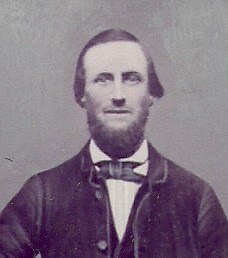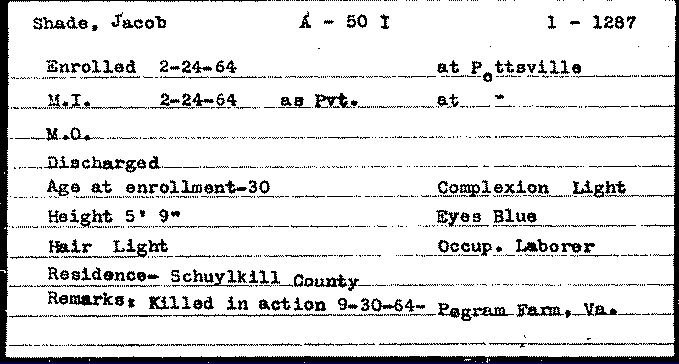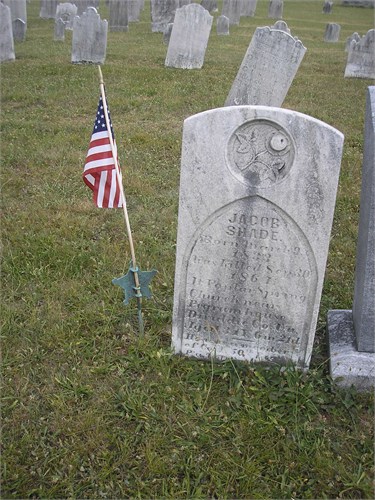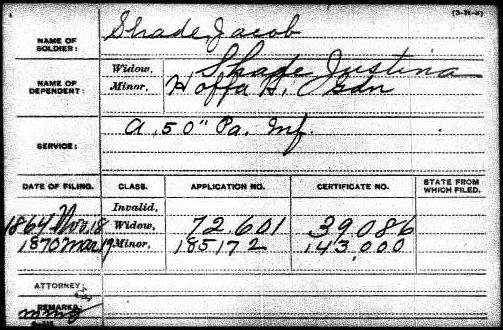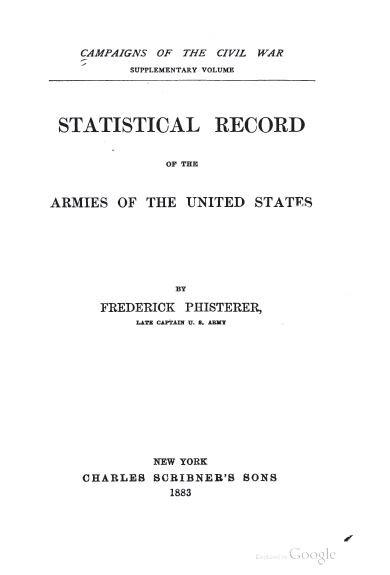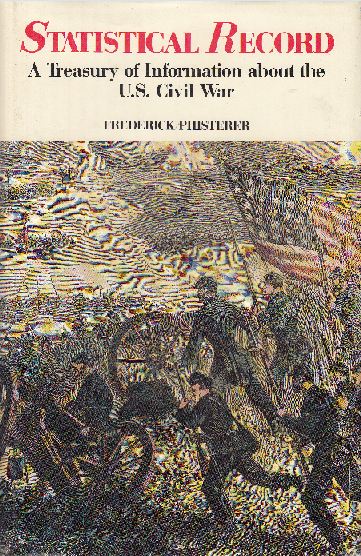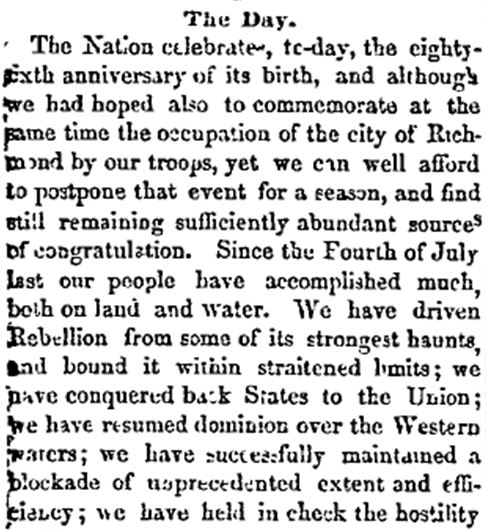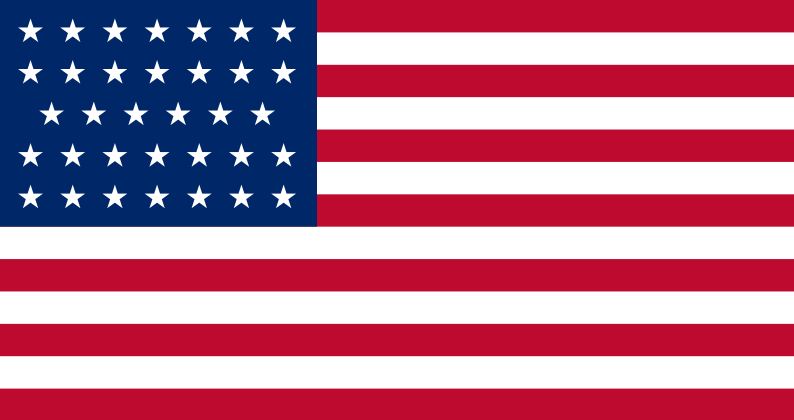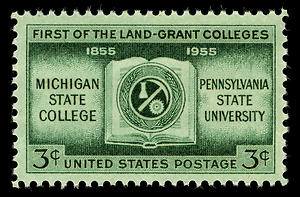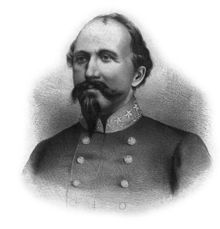Posted By Norman Gasbarro on July 3, 2012
William H. Hawk (1844-1912) lived through the tragic death of his mother and of his son in addition to honorably serving in the Civil War in the 11th Pennsylvania Infantry and in the Veteran Reserve Corps. The record shows that he he was wounded at Gettysburg on 1 July 1863 and at the Wilderness on 5 May 1864.
William H. Hawk was the son of Daniel Hawk (1812-1894), sometimes referred to as Daniel Haag, a laborer, and his wife Nancy [Bender] Hawk (1812-1859). Nancy was a direct descendant of Adam Bender, the founder of Elizabethville, Dauphin County, when it was known as Benderstettle.
When William was fifteen years old, his mother was found dead. Her death remains a mystery to this day, many believing she was murdered. The story that appeared in the Pennsylvania Daily Telegraph, on 27 July 1859 is as follows:
WOMAN HUNG — MYSTERIOUS AFFAIR — On Sunday morning last a woman named Mrs. Haag, wife of a respectable laboring man in Washington Township, left home to go over the mountain on a visit to her aunt. About ten o’clock she was seen in a field of Mr. John Anspach, one mile from her residence, picking and eating blueberries. She did not reach her destination and nothing afterwards was seen or heard of her until about ten o’clock yesterday morning, when she was found dead, at the foot of the mountain about one hundred yards from the Lykens Valley Railroad. She was sitting on a log with a black ribbon around her neck, to which was attached a calico string, the latter being tied to the limb of a tree –. Her comb and her collar were found on the ground about nine feet distant. Some teeth, broken out of the comb, were sticking in her hair. A wound was noticed on the side of her neck, and bruises on her legs. Aaron P. Lark, Esq., summoned a jury and held an inquest on the body, who, after an investigation, returned a verdict that the woman came to her death by the hands of some person or persons unknown. Some of the people in that region are of opinion that Mrs. Haag hung herself; others think she was murdered, and this seems to be the opinion of the jury. When the family of Mrs. Haag were summoned to the spot, the children wept bitterly, one of them remarking to her father that “he had said to much to mother the morning she left.” We learn that he and his wife did not live very peaceably, and that domestic quarrels were of frequent occurrence. He is an industrious, honest, peaceable man, respected by his neighbors, and provided well for his family. We give the particulars of the affair as furnished to us this morning by a gentleman who resides in the neighborhood. Whether the woman committed suicide, or was murdered, is a mystery that remains to be solved. The marks of violence upon her person, the evidence of there having been a struggle, the appearance of the neck and face, and the position in which she was found, satisfied the jury that the woman had been foully dealt with.
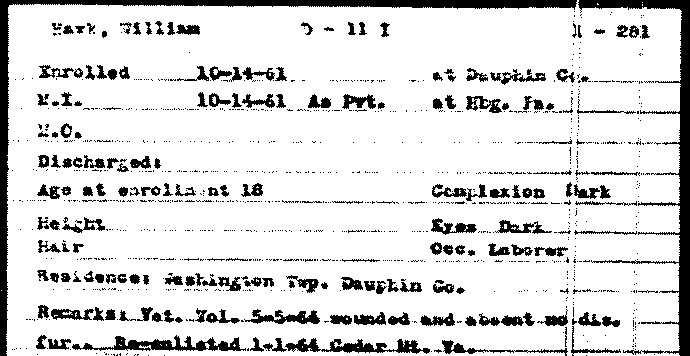
William H. Hawk followed the same line of work as his father and became a laborer as his Pennsylvania Veterans’ Index Card shows (above). Other than the notation that he had “dark eyes” and that he was eighteen years old, no other physical description appears in this Civil War record. William was actually only 17 when he enrolled in the 11th Pennsylvania Infantry, Company D, as a Private, 14 October 1861, in Dauphin County. Other records say he enrolled on 27 November 1861 in Lycoming County.
On the Pennsylvania Veterans’ Index Card, a re-enlistment date of 1 January 1864 at Cedar Mountain, Virginia, is given as well as a the notation that he was wounded and absent on 5 May 1864. Bates notes that William was also wounded at Gettysburg on 1 July 1863.

Click on plaque to enlarge.
The portion of the plaque on the Pennsylvania Memorial at Gettysburg which shows Company D, 11th Pennsylvania Infantry, is shown above with William Hawk‘s name noted.
According to several databases including “American Civil War Soldiers” and “United States Civil War Soldier Records and Profiles,” William H. Hawk was mustered out of the service at Harrisburg, 1 July 1865. These records are available through Ancestry.com. However, there is a conflict in William’s service record as it appears on the Pension Index Card (shown below).
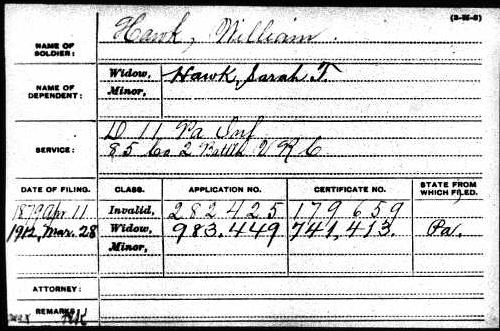
The Pension Index Card notes service in the 2nd Battalion of the “V.R.C.” (the Veteran Reserve Corps), Did William serve in the Veteran Reserve Corps for a time and then return to the 11th Pennsylvania Infantry? Or, did he serve in the Veteran Reserve Corps after he recovered from his wounds at the Wilderness, 5 May 1864?
The Pension Index Card is also revealing of the fact that William’s pension application was in 1879, which indicates that his disability or invalid status was probably connected to his war injuries. The pension was received and when William died, his widow, Sarah, applied for and received his benefits.
William H. Hawk married Sarah Tilda Kocher sometimes referred to as Sophie, on 10 December 1866 in Berrysburg, Dauphin County. To their union were born many children, the last of which was probably born in 1887. In 1870, the family was living in Lykens Township and William was working as a laborer. In 1880, the family was living in Wiconisco Township and William was working as a laborer. In 1890, the family was living in Wiconisco and William stated that he was a “re-enlisted” veteran but did not cite any disabilities as a result of his war service. No mention was made of service in the Veteran Reserve Corps – only service in the 11th Pennsylvania Infantry. By 1900, the family had moved to Lykens Borough, and William, along with his two sons, William Hawk aged 18 and Lincoln Hawk aged 16, were working in the coal mines.
The second major tragedy of William H. Hawk‘s life occurred in October 1903 when one son was killed in the mines and another son was seriously injured. As reported in the Lykens Standard, 30 October 1903:
Fatal Mine Accident
Walter William Hawk, employed with his brother, John H. Hawk, in driving a breast in No. 6 counter, Short Mountain Colliery, was instantly killed by a fall of rock at 10:30 a.m. Friday last, and his brother painfully bruised about the limbs. Deceased was a son of William Hawk and Sarah [Kocher] Hawk of North Street, this Borough, and was born 28 Jun 1882. He was aged 21 years, 3 months, and 25 days. A father and mother, three brothers, Cornelius Hawk, John H. Hawk and Lincoln Hawk, and five sisters, Mrs. Newton Koppenheffer, Mrs. George Hawk, Mrs. William Kreiner and Mrs. Reese Evans, together with an adopted sister, Grace Hawk, mourn his death.
Mr. Hawk was a member of Washington camp, No. 238, P.O.S. of A. of this place, and also of the local Mine Workers’ Union. In both of these organizations he showed himself to be a faithful and loyal member.
The funeral took place Monday afternoon, both organizations of which he was a member attending in a body, besides a large number of relatives and friends. The funeral was in charge of the P.O.S. of A., from whose membership the following pallbearers were selected: Richard Noble, Jacob Gratz, Lewis Barrett, John Hand, Howard Wallace and Blaine Hoffman. Services were held in Christ reformed Church, Rev. L. M. Fetterolf preaching the sermon from Jeremiah 15:9. The interment took place in Wiconisco Cemetery.
William H. Hawk died on 23 March 1912 having lived a hard life as a laborer and coal miner, having suffered two major tragedies in his life (the murder of his mother and the loss of his son in a coal mine accident), an an honorable Civil War service that included being wounded twice.
His obituary appeared in a local newspaper:
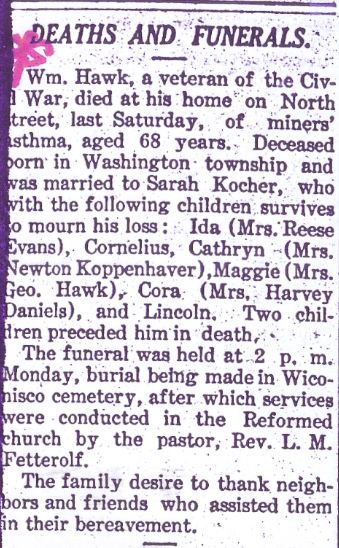
DEATHS AND FUNERALS
William Hawk, a veteran of the Civil War, died at his home on North Street, last Saturday, of miners’ asthma, aged 68 years. Deceased was born in Washington Township and was married to Sarah Kocher, who with the following children survives to mourn his loss: Ida (Mrs. Reese Evans); Cornelius Hawk; Cathryn (Mrs. Newton Koppenhaver); Maggie (Mrs. George Hawk); Cora (Mrs. Harvey Daniels), and Lincoln Hawk. Two children preceded him in death.
The funeral was held at 2 p.m. Monday, burial being made in Wiconisco Cemetery, after which services were conducted in the Reformed Church by the pastor, Rev. L. M. Fetterolf.
The family desire to thank neighbors and friends who assisted them in their bereavement.
William Hawk is recognized on the Heilner Post G.A.R. Monument in Lykens Borough:
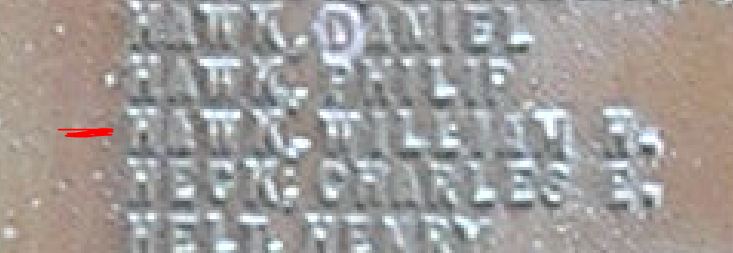
On 12 August 1912, Sarah Hawk died. Her obituary was also reported in a local newspaper:
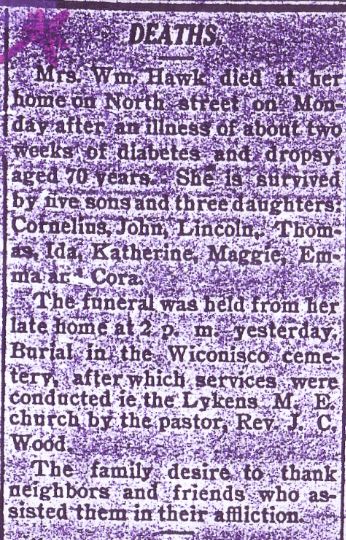
DEATHS
Mrs. William Hawk died at her home on North Street on Monday after an illness of about two weeks of diabetes and dropsy, aged 70 years. She is survived by five sons and three daughters: Cornelius Hawk, John Hawk; Lincoln Hawk; Thomas Hawk; Ida Hawk; Katherine Hawk; Maggie Hawk; Emma Hawk; and Cora Hawk.
The funeral was held from her late home at 2 p.m. yesterday. Burial in the Wiconisco Cemetery, after which services were conducted in the Lykens Methodist Episcopal Church by the pastor, Rev. J. C. Wood.
The family desire to than neighbors and friends who assisted them in their affliction.
It is not known why there is a discrepancy in the named children when William died and when Sarah died. Also, the married names of the girls were given in the father’s obituary, but in the mother’s obituary, only the first names of the girls were given.
The Civil War Research Project has a file of materials on William H. Hawk that includes pension application information, some vital records (marriage, death, etc.), news clippings and summaries of military records. However, there are no pictures of William or his family. A picture of his grave marker previously appeared on this blog in the post entitled Calvary United Methodist Church and Cemetery (Part 3 of 6). Additional information is sought on William H. Hawk and readers are invited to contribute.
Pension Index Cards are from Ancestry.com and reference files available at the National Archives in Washington, D.C. Pennsylvania Veterans’ Index Cards are available from the Pennsylvania Archives.
Category: Research, Resources, Stories |
Comments Off on Tragedies in the Life of William H. Hawk
Tags: Berrysburg, Elizabethvile, Elizabethville, G.A.R., Lykens Borough, Lykens Township, Regiments, Washington Township, Wiconisco, Wiconisco Township, Women
 ;
;
